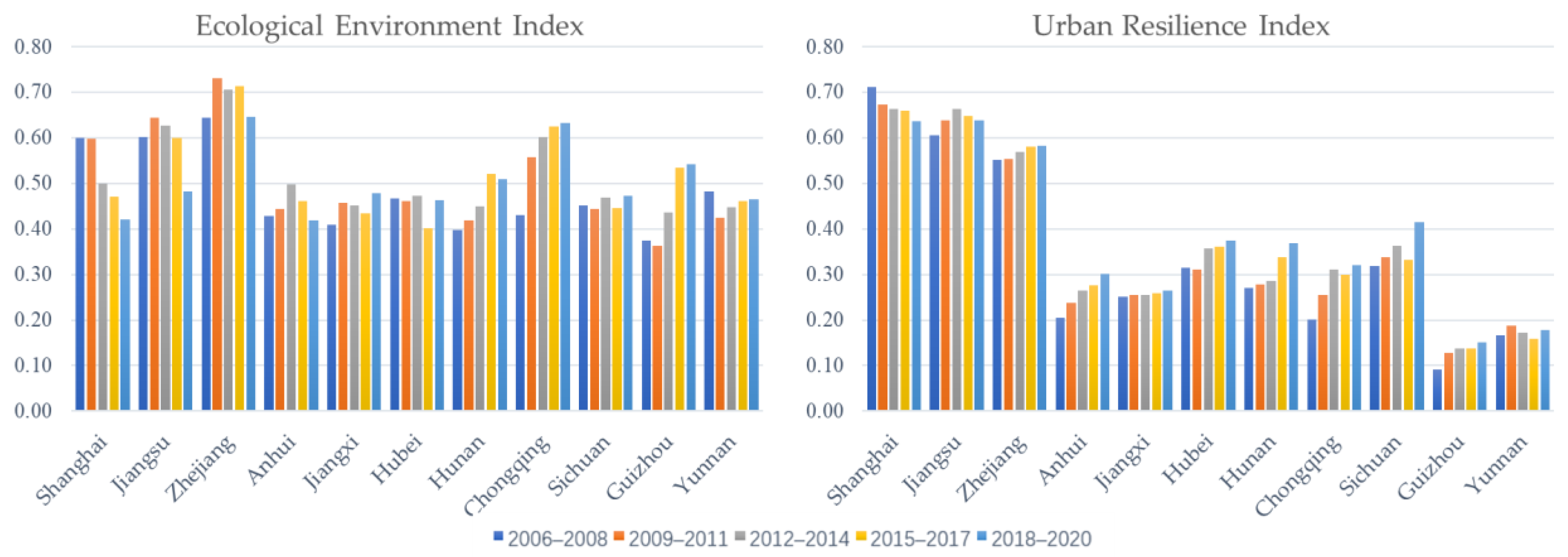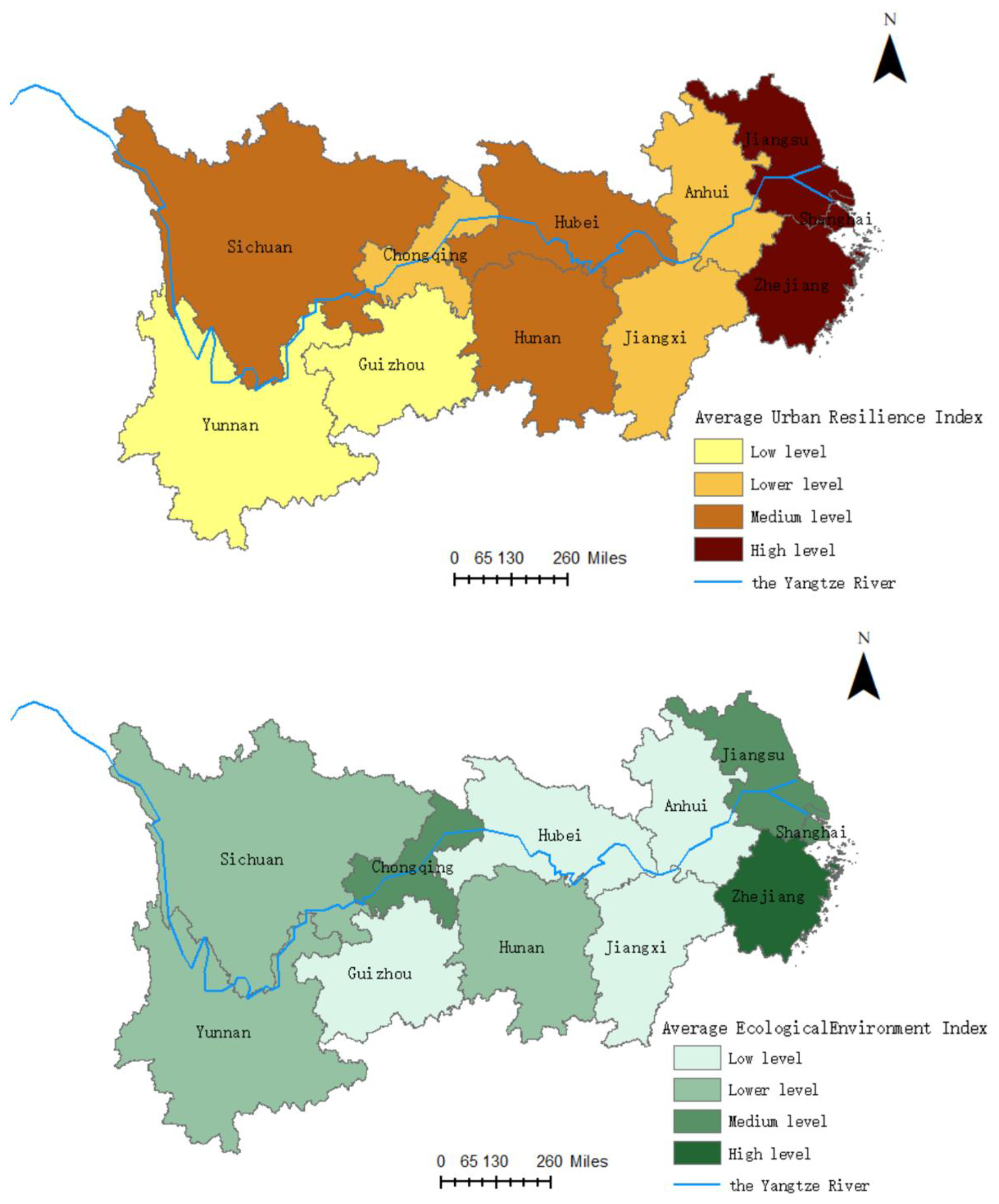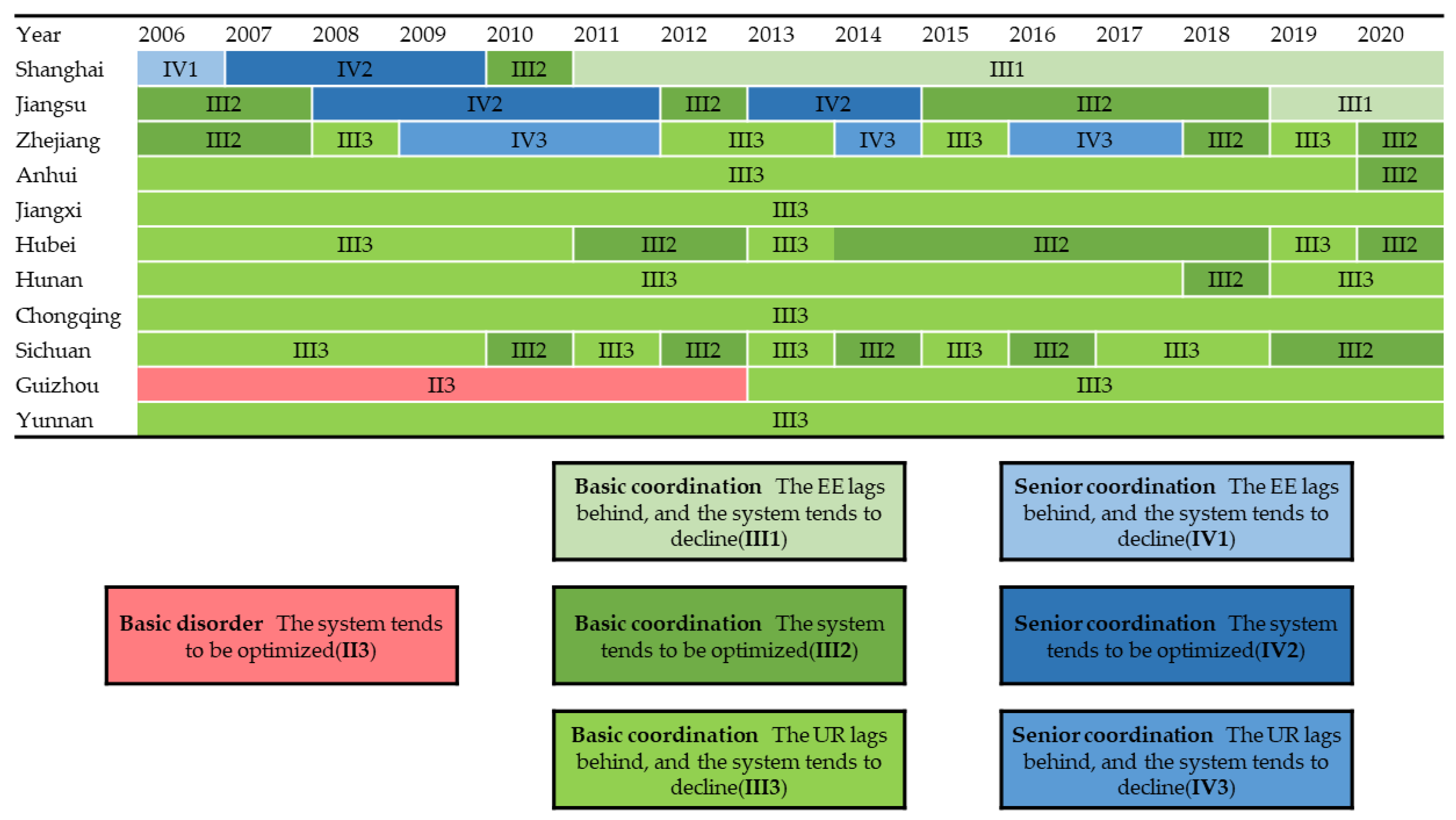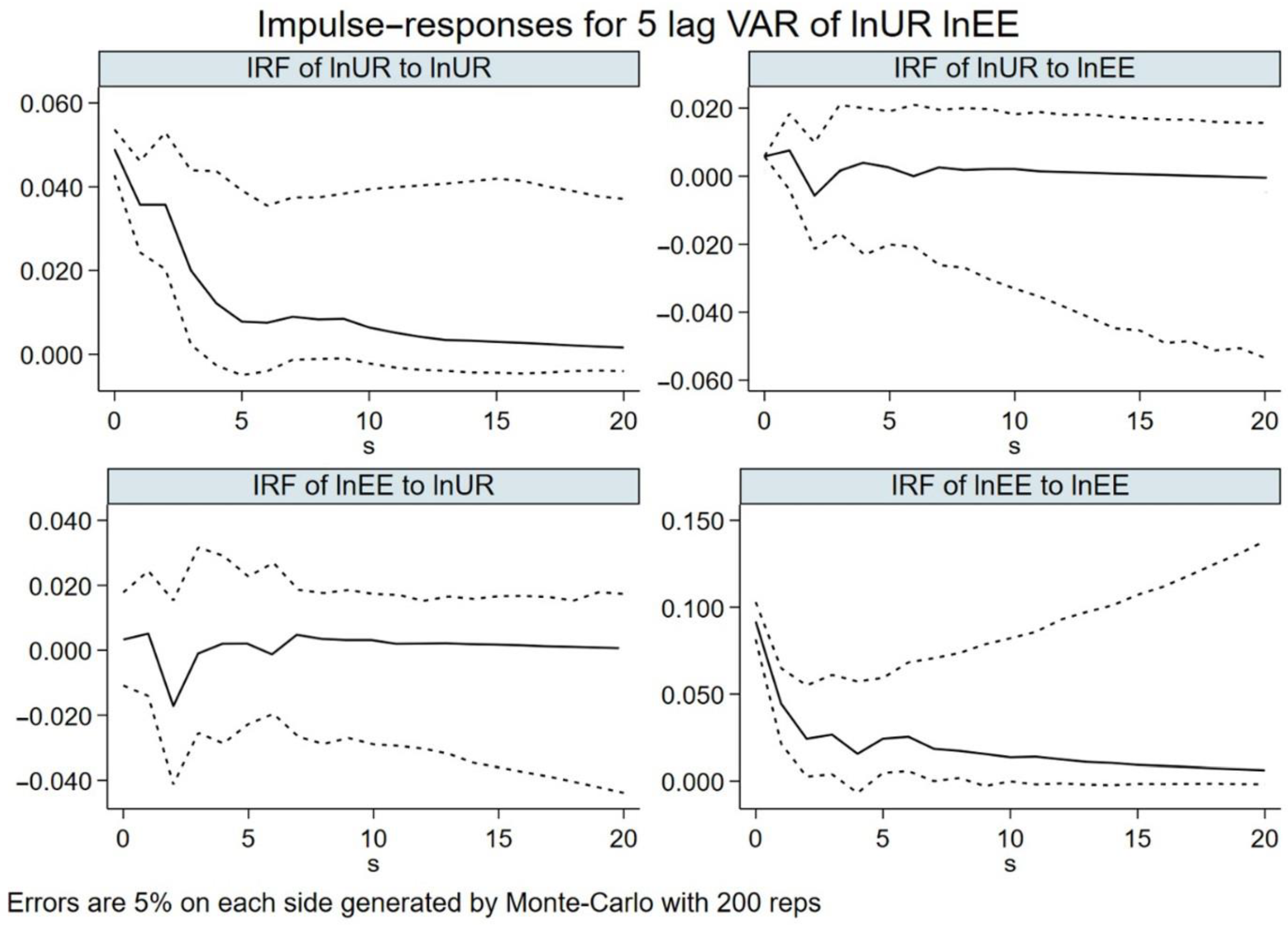Coupling Coordination and Interactive Response Analysis of Ecological Environment and Urban Resilience in the Yangtze River Economic Belt
Abstract
1. Introduction
2. Theoretical Framework and Coordination Mechanism
2.1. Theoretical Basis: Sustainable Development Theory
2.2. The Mechanism of Ecological Environment on Urban Resilience
2.3. The Mechanism of Urban Resilience on the Ecological Environment
3. Materials and Methods
3.1. Ecological Environment Index (EE) and Urban Resilience Index (UR)
3.1.1. Construction of Evaluation Index System
3.1.2. Comprehensive Index Evaluation Method
3.2. Coupling Coordination Degree Model
3.3. The Panel Vector Autoregressive Model (PVAR)
3.4. Data Sources
4. Results
4.1. Analysis of Coupling Coordination Degree between the EE and UR
4.1.1. Ecological Environment Index (EE) and Urban Resilience Index (UR)
4.1.2. Coupling Coordination Degree between the EE and UR
4.2. Empirical Analysis of the PVAR
4.2.1. Stationarity Analysis
4.2.2. Lag Order Test
4.2.3. GMM of the PVAR
4.2.4. Impulse Response Analysis
4.2.5. Variance Decomposition Model
5. Discussion
6. Conclusions
Author Contributions
Funding
Institutional Review Board Statement
Informed Consent Statement
Data Availability Statement
Conflicts of Interest
References
- Spaans, M.; Waterhout, B. Building up resilience in cities worldwide—Rotterdam as participant in the 100 Resilient Cities Programme. Cities 2017, 61, 109–116. [Google Scholar] [CrossRef]
- Zhang, M.; Liu, Y.; Wu, J.; Wang, T. Index system of urban resource and environment carrying capacity based on ecological civilization. Environ. Impact Assess. 2018, 68, 90–97. [Google Scholar] [CrossRef]
- Fang, J.; Kiang, C.S.; Greenbaum, D.S.; O’Keefe, R.M. China’s Environment: Challenges and Solutions. Guest Editorial. Frontiers in Ecological and Environmental Sciences: Special Issue on China’s Environment; Ecological Society of America: Washington, DC, USA, 2006. [Google Scholar]
- Liu, M.; Xie, H.; He, Y.; Zhang, Q.; Sun, X.; Yu, C.; Chen, L.; Zhang, W.; Zhang, Q.; Wang, X. Sources and transport of methylmercury in the Yangtze River and the impact of the Three Gorges Dam. Water Res. 2019, 166, 115042. [Google Scholar] [CrossRef] [PubMed]
- Yang, H.; Zhong, X.; Deng, S.; Xu, H. Assessment of the impact of LUCC on NPP and its influencing factors in the Yangtze River basin, China. Catena 2021, 206, 105542. [Google Scholar] [CrossRef]
- Ribeiro, P.J.G.; Gonçalves, L.A.P.J. Urban resilience: A conceptual framework. Sustain. Cities Soc. 2019, 50, 101625. [Google Scholar] [CrossRef]
- Cannon, T. Vulnerability Analysis, Livelihoods and Disasters. RISK21-Coping with Risks Due to Natural Hazards in the 21st Century, 1st ed.; CRC Press: Boca Raton, FL, USA, 2006; pp. 51–60. [Google Scholar]
- Wilbanks, T.J.; Sathaye, J. Integrating Mitigation and Adaptation as Responses to Climate Change: A Synthesis. Mitig. Adapt. Strateg. Glob. Chang. 2007, 12, 957–962. [Google Scholar] [CrossRef]
- Bruneau, M.; Chang, S.E.; Eguchi, R.T. A Framework to Quantitatively Assess and Enhance the Seismic Resilience of Communities. Earthq. Spectra 2012, 19, 733–752. [Google Scholar] [CrossRef]
- Feng, J.; Liu, Y.; Wang, J.; ZHANG, H. The Impact of Economic Development and Environmental Pressure on Urban Resilience: Based on Panel Data of 11 Prefecture-Level Cities in Shanxi. Ecol. Econ. 2020, 36, 101–106+163. [Google Scholar]
- Zhu, S.; Li, D.; Feng, H. Is smart city resilient? Evidence from China. Sustain. Cities Soc. 2019, 50, 101636. [Google Scholar] [CrossRef]
- Song, Y. Ecological city and urban sustainable development. Procedia Eng. 2011, 21, 142–146. [Google Scholar] [CrossRef]
- Desouza, K.C.; Trevor, H. Designing, planning, and managing resilient cities: A conceptual framework. Cities 2013, 35, 89–99. [Google Scholar] [CrossRef]
- Ma, D.; Shen, Z. Research on Coupling Coordination of Urban Resilience and Economic Development Level–Taking Beijing—Tianjin-Hebei Urban Agglomeration as an Example. Resour. Dev. Mark. 2021, 37, 820–821+827+822–826. [Google Scholar]
- Gao, Y.; Chen, W. Study on the coupling relationship between urban resilience and urbanization quality—A case study of 14 cities of Liaoning Province in China. PLoS ONE 2021, 16, e0244024. [Google Scholar] [CrossRef] [PubMed]
- Luo, X.; Cheng, C.; Pan, Y.; Yang, T. Coupling Coordination and Influencing Factors of Land Development Intensity and Urban Resilience of the Yangtze River Delta Urban Agglomeration. Water 2022, 14, 1083. [Google Scholar] [CrossRef]
- He, J.H.; Wu, Y.M.; Li, C. Research on the Coordinated Development of Urban Urban Resilience and Technological Innovation--Taking Chengdu-Chongqing Economic Circle as an Example. Resour. Dev. Mark. 2022, 38, 46–52. [Google Scholar]
- Grossman, G.; Krueger, A. Economic growth and the environment. Q. J. Econ. 1995, 110, 353–377. [Google Scholar] [CrossRef]
- Geng, Y.Q.; Wei, Z.J.; Zhang, H.; Maimaituerxun, M. Analysis and Prediction of the Coupling Coordination Relationship between Tourism and Air-Environment: Yangtze River Economic Zone in China as Example. Discret. Dyn. Nat. Soc. 2020, 2020, 1406978. [Google Scholar] [CrossRef]
- Ren, Y.; Bai, Y.; Liu, Y.; Wang, J.; Zhang, F. Conflict or Coordination? Analysis of Spatio-Temporal Coupling Relationship between Urbanization and Eco-Efficiency: A Case Study of Urban Agglomerations in the Yellow River Basin, China. Land 2022, 11, 882. [Google Scholar] [CrossRef]
- Fan, Y.; Fang, C.; Zhang, Q. Coupling coordinated development between social economy and ecological environment in Chinese provincial capital cities-assessment and policy implications. J. Clean Prod. 2019, 229, 289–298. [Google Scholar] [CrossRef]
- State Council. Guidance of the State Council on Relying on the Golden Waterway to Promote the Development of Yangtze River Economic Belt. Available online: http://www.gov.cn/zhengce/content/2014-09/25/content_9092.htm (accessed on 27 June 2022).
- Niu, W.Y. The theoretical connotation of sustainable development: The 20th Anniversary of UN Conference on Environment and Development in Rio de Janeiro, Brazil. China Popul. Resour. Env. 2012, 22, 9–14. [Google Scholar]
- Hu, D.; Deng, M. A review of sustainable development theory and sustainable development of hospitals. Chin. Hosp. Manag. 2004, 24, 42–45. [Google Scholar]
- Li, C. United Nations summit seeks global development. Contemp. World 2005, 10, 4–6. [Google Scholar]
- United Nations. Transforming Our World: The 2030 Agenda for Sustainable Development; United Nations: New York, NY, USA, 2015; ISBN 9780826190123.
- Elkington, J.; Rowlands, I.H. Cannibals with forks: The triple bottom line of 21st century business. Altern. J. 1999, 25, 42. [Google Scholar]
- Shi, L.; Han, L.; Yang, F.; Gao, L. The Evolution of Sustainable Development Theory: Types, Goals, and Research Prospects. Sustainability 2019, 11, 7158. [Google Scholar] [CrossRef]
- Zheng, H. Developmentalism and consumerism: The difficult situation and outlet of developing countries’ social development. J. Huazhong Univ. Sci. Tech. (Soc. Sci. Ed.) 2005, 4, 51–55. [Google Scholar]
- Zhang, X. Sustainable development theory: Conceptual evolution, dimensions and outlook. P. Chin. Acad. Sci. 2018, 33, 10–19. [Google Scholar]
- Niu, W.Y. Basic Knowledge of Sustainable Development Theory. Prog. Geog. 2008, 3, 1–6. [Google Scholar]
- Liu, L.; Liang, L.; Gao, P.; Fan, C.; Wang, H. Coupling relationship and interactive response between ecological protection and high- quality development in the Yellow River Basin. J. Nat. Reso. 2021, 36, 176–195. [Google Scholar] [CrossRef]
- New Knowledge and New Insights: Coordinate the Promotion of Ecological Protection and Economic Development. Available online: http://theory.people.com.cn/n1/2020/0702/c40531-31767587.html (accessed on 28 June 2022).
- Ecological and Environmental Protection Depends on Scientific and Technological Innovation. Available online: https://baijiahao.baidu.com/s?id=1644796903083561572&wfr=spider&for=pc (accessed on 28 June 2022).
- Wu, J.; Wang, X.; Zhong, B.; Yang, A.; Jue, K.; Wu, J.; Zhang, L.; Xu, W.; Wu, S.; Zhang, N.; et al. Ecological environment assessment for Greater Mekong Subregion based on Pressure-State-Response framework by remote sensing. Ecol. Indic. 2020, 117, 106521. [Google Scholar] [CrossRef]
- Zheng, Y.; Xin-Lu, X.; Chen-Zhen, L.; Mou, W.; Xiao-Jia, H.E. Development as adaptation: Framing and measuring urban resilience in Beijing. Adv. Clim. Chang. Res. 2018, 9, 234–242. [Google Scholar] [CrossRef]
- Liu, L.; Luo, Y.; Pei, J.; Wang, H.; Li, J.; Li, Y. Temporal and Spatial Differentiation in Urban Resilience and Its Influencing Factors in Henan Province. Sustainability 2021, 13, 12460. [Google Scholar]
- Miltojević, V.; Ilić-Krstić, I. Cultural Dimension of Sustainable Development as a Presumtion of Local Communities Development. Qual. Life 2011, 3, 33–37. [Google Scholar] [CrossRef][Green Version]
- UNESCO. Universal Declaration on Culture Diversity; UNESCO: Paris, France, 2001; Available online: http://www.unesco.org/new/fileadmin/MULTIMEDIA/HQ/CLT/pdf/5_Cultural_Diversity_EN.pdf (accessed on 13 December 2019).
- Liu, Y.P. Urban Resilience System Development Measurement: Based on an Empirical Study of 288 Chinese Cities. Urban Dev Stud 2021, 28, 77–87. [Google Scholar]
- Martin, R.; Sunley, P. On the notion of regional economic resilience: Conceptualization and explanation. J Econ. Geogr. 2015, 15, 1–42. [Google Scholar] [CrossRef]
- Alberti, M.; Marzluff, J.M.; Shulenberger, E.; Bradley, G.; Ryan, C.; Zumbrunnen, C. Integrating Humans into Ecology: Opportunities and Challenges for Studying Urban Ecosystems. BioScience 2003, 53, 1169–1179. [Google Scholar] [CrossRef]
- Chopra, S.S.; Dillon, T.; Bilec, M.M.; Khanna, V. A network-based framework for assessing infrastructure resilience: A case study of the London metro system. J. R. Soc. Interface 2016, 118, 20160113. [Google Scholar]
- Shi, T.; Qiao, Y.; Zhou, Q.; Zhang, J. The regional differences and random convergence of urban resilience in China. Technol. Econ. Dev. Econ. 2022, 28, 979–1002. [Google Scholar]
- Liu, D.-J.; Li, L. Application Study of Comprehensive Forecasting Model Based on Entropy Weighting Method on Trend of PM2.5 Concentration in Guangzhou, China. Int. J. Environ. Res. Public Health 2015, 12, 7085–7099. [Google Scholar]
- Li, S.; Liu, H.N. Spatio-temporal pattern evolution of coupling coordination between urbanization and ecological resilience in arid region: A case of Ningxia Hui Autonomous Region. Arid Land Geogr. 2022, 45, 1281–1290. [Google Scholar]
- Tang, Z. An integrated approach to evaluating the coupling coordination between tourism and the environment. Tour. Manag. 2015, 46, 11–19. [Google Scholar]
- Wang, Z.J.; Cui, Z.T.; Lin, J.J.; Xie, J.Y.; Su, K. Coupling relationship between urbanization and ecological resilience in the Pearl River Delta. Acta. Geogr. Sin. 2021, 76, 973–991. [Google Scholar] [CrossRef]
- Gan, C.; Wang, K. Research on Coupling Coordination of Tourism Development and Economic Resilience in Hunan Province. Geogr. Inf. Sc. 2022, 38, 127–144. [Google Scholar]
- Liu, H.; Liang, S.; Cui, Q. The Nexus between Economic Complexity and Energy Consumption under the Context of Sustainable Environment: Evidence from the LMC Countries. Int. J. Environ. Res. Public Health 2021, 18, 124. [Google Scholar] [CrossRef]
- LÜTKEDOHL, H. Introduction to multiple time series analysis. J. Am. Stat. Assoc. 1993, 87, 1243–1254. [Google Scholar]
- Gabriel, L.F.; de Santana Ribeiro, L.C. Economic growth and manufacturing: An analysis using Panel VAR and intersectoral linkages. Struct. Chang. Econ. Dyn. 2019, 49, 43–61. [Google Scholar]
- Love, I.; Zicchino, L. Financial development and dynamic investment behavior: Evidence from panel VAR. Q. Rev. Econ. Finance 2006, 46, 190–210. [Google Scholar]
- Shi, T. The Analysis of the Spatiotemporal Evolution and Driving Factors of Urban Resilience in Yellow River Basin. Region. Econ. Rev. 2022, 1, 139–149. [Google Scholar]





| Target | Dimensions | Indicators | Properties | Weights |
|---|---|---|---|---|
| Ecological Environment | Pressure (0.27) | Natural disaster damage | − | 0.08 |
| COD emissions in industrial wastewater per unit of GDP | − | 0.07 | ||
| Industrial sulfur dioxide emissions per unit of GDP | − | 0.05 | ||
| Fertilizer application amount per unit of agricultural output value | − | 0.07 | ||
| State (0.32) | Excellent air quality rate | + | 0.08 | |
| Water resources per capita | + | 0.09 | ||
| Forest cover rate | + | 0.09 | ||
| Green space per capita | + | 0.07 | ||
| Response (0.41) | Soil erosion control area | + | 0.1 | |
| Energy conservation and environmental protection expenditure as a percentage of GDP | + | 0.08 | ||
| Municipal domestic waste removal volume | + | 0.14 | ||
| Municipal sewage treatment rate | + | 0.08 | ||
| Urban Resilience | Economic resilience (0.24) | GDP per capita | + | 0.04 |
| Production of tertiary sector in GDP | + | 0.04 | ||
| Per capita disposable income of urban residents | + | 0.06 | ||
| Local public finance revenue | + | 0.04 | ||
| Actual amount of foreign capital used in the year | + | 0.04 | ||
| Growth of in Fixed assets investment per capita | + | 0.02 | ||
| Social resilience (0.19) | Population density | + | 0.04 | |
| Urban registered unemployment rate | - | 0.03 | ||
| Number of beds in health care institutions | + | 0.03 | ||
| Regional urbanization rate | + | 0.03 | ||
| Share of social security expenditure in fiscal expenditure | + | 0.03 | ||
| Pension insurance coverage rate | + | 0.03 | ||
| Ecological resilience (0.12) | Greening coverage rate of built-up areas | + | 0.02 | |
| Forest cover rate | + | 0.02 | ||
| Industrial smoke (powder) dust emissions per unit of GDP | − | 0.02 | ||
| Industrial wastewater emissions per unit of GDP | − | 0.02 | ||
| Harmless treatment rate of domestic waste | + | 0.02 | ||
| Comprehensive utilization rate of industrial solid waste | + | 0.03 | ||
| Infrastructure resilience (0.19) | Number of public buses per 10,000 people | + | 0.02 | |
| Number of Internet broadband access users | + | 0.04 | ||
| Electricity consumption per capita | + | 0.05 | ||
| Daily domestic water consumption per catipa | + | 0.02 | ||
| Total city gas supply | + | 0.04 | ||
| Urban road area per capita | + | 0.02 | ||
| Cultural resilience (0.26) | Proportion of public cultural expenditure to local budget expenditure | + | 0.03 | |
| Number of books in public libraries per 100 people | + | 0.09 | ||
| Number of people employed in culture, sports and entertainment per 10,000 people | + | 0.03 | ||
| Regional cable radio and television subscribers | + | 0.04 | ||
| Number of college students in general higher education institutions | + | 0.03 | ||
| The proportion of the population with a college degree and above in the population over the age of 15 | + | 0.05 |
| D | Type | Relative Size of UR and EE | Feature | Code |
|---|---|---|---|---|
| 0 ≤ D < 0.3 | Severe disorder | UR−EE > 0.1 | Severe disorder—The EE lags behind, and the system tends to decline | I1 |
| 0 ≤ |UR−EE| ≤ 0.1 | Severe disorder—The system tends to be optimized | I2 | ||
| EE−UR > 0.1 | Severe disorder—The UR lags behind, and the system tends to decline | I3 | ||
| 0.3 ≤ D < 0.5 | Basic disorder | UR−EE > 0.1 | Basic disorder—The EE lags behind, and the system tends to decline | II1 |
| 0 ≤ |UR−EE| ≤ 0.1 | Basic disorder—The system tends to be optimized | II2 | ||
| EE−UR > 0.1 | Basic disorder—The UR lags behind, and the system tends to decline | II3 | ||
| 0.5 ≤ D < 0.8 | Basic coordination | UR−EE > 0.1 | Basic coordination—The EE lags behind, and the system tends to decline | III1 |
| 0 ≤ |UR−EE| ≤ 0.1 | Basic coordination—The system tends to be optimized | III2 | ||
| EE−UR > 0.1 | Basic coordination—The UR lags behind, and the system tends to decline | III3 | ||
| 0.8 ≤ D < 1 | Senior coordination | UR−EE > 0.1 | Senior coordination—The EE lags behind, and the system tends to decline | IV1 |
| 0 ≤ |UR−EE| ≤ 0.1 | Senior coordination—The system tends to be optimized | IV2 | ||
| EE−UR > 0.1 | Senior coordination—The UR lags behind, and the system tends to decline | IV3 |
| Year | Shanghai | Jiangsu | Zhejiang | Anhui | Jiangxi | Hubei | Hunan | Chongqing | Sichuan | Guizhou | Yunnan |
|---|---|---|---|---|---|---|---|---|---|---|---|
| 2006 | 0.80 | 0.76 | 0.77 | 0.55 | 0.56 | 0.62 | 0.57 | 0.55 | 0.62 | 0.43 | 0.53 |
| 2007 | 0.81 | 0.77 | 0.77 | 0.54 | 0.56 | 0.61 | 0.55 | 0.52 | 0.59 | 0.44 | 0.52 |
| 2008 | 0.81 | 0.80 | 0.78 | 0.55 | 0.57 | 0.62 | 0.59 | 0.56 | 0.63 | 0.42 | 0.54 |
| 2009 | 0.83 | 0.80 | 0.80 | 0.54 | 0.58 | 0.62 | 0.58 | 0.57 | 0.62 | 0.48 | 0.54 |
| 2010 | 0.78 | 0.80 | 0.80 | 0.58 | 0.58 | 0.62 | 0.59 | 0.61 | 0.60 | 0.47 | 0.53 |
| 2011 | 0.78 | 0.80 | 0.80 | 0.58 | 0.59 | 0.61 | 0.58 | 0.66 | 0.65 | 0.44 | 0.52 |
| 2012 | 0.78 | 0.78 | 0.78 | 0.59 | 0.59 | 0.61 | 0.58 | 0.65 | 0.64 | 0.49 | 0.53 |
| 2013 | 0.75 | 0.81 | 0.79 | 0.61 | 0.58 | 0.66 | 0.59 | 0.65 | 0.66 | 0.50 | 0.54 |
| 2014 | 0.75 | 0.82 | 0.81 | 0.61 | 0.58 | 0.65 | 0.62 | 0.67 | 0.63 | 0.50 | 0.52 |
| 2015 | 0.73 | 0.79 | 0.79 | 0.59 | 0.60 | 0.61 | 0.63 | 0.65 | 0.62 | 0.51 | 0.50 |
| 2016 | 0.74 | 0.79 | 0.81 | 0.60 | 0.56 | 0.62 | 0.66 | 0.67 | 0.61 | 0.52 | 0.52 |
| 2017 | 0.77 | 0.79 | 0.81 | 0.61 | 0.58 | 0.62 | 0.65 | 0.65 | 0.62 | 0.53 | 0.53 |
| 2018 | 0.74 | 0.75 | 0.78 | 0.60 | 0.59 | 0.65 | 0.62 | 0.67 | 0.66 | 0.54 | 0.56 |
| 2019 | 0.71 | 0.74 | 0.79 | 0.59 | 0.57 | 0.66 | 0.66 | 0.64 | 0.69 | 0.54 | 0.51 |
| 2020 | 0.70 | 0.74 | 0.78 | 0.59 | 0.62 | 0.62 | 0.69 | 0.70 | 0.65 | 0.53 | 0.54 |
| Average value | 0.77 | 0.78 | 0.79 | 0.58 | 0.58 | 0.63 | 0.61 | 0.63 | 0.63 | 0.49 | 0.53 |
| Variables | LLC Statistic | IPS Statistics | ADF-Fisher Statistics |
|---|---|---|---|
| lnUR | −5.0286 *** (0.000) | −4.1691 *** (0.000) | 6.4645 *** (0.000) |
| lnEE | −4.8163 *** (0.000) | −3.4650 *** (0.000) | 3.0253 *** (0.001) |
| lag | AIC | BIC | HQIC |
|---|---|---|---|
| 1 | −2.41559 | −1.87689 | −2.19669 |
| 2 | −3.76758 | −3.11240 | −3.50135 |
| 3 | −4.10648 | −3.32088 * | −3.78742 |
| 4 | −4.19745 | −3.26455 | −3.81906 |
| 5 | −4.28430 * | −3.18334 | −3.83885 * |
| Variables | Explained Variable lnUR | Variables | Explained Variable lnEE |
|---|---|---|---|
| L1_lnUR | 0.728 *** (6.05) | L1_lnUR | 0.072 (0.30) |
| L2_lnUR | 0.206 (1.57) | L2_lnUR | −0.456 ** (−1.07) |
| L3_lnUR | −0.257 *** (−2.84) | L3_lnUR | 0.418 * (2.24) |
| L4_lnUR | −0.073 (−0.59) | L4_lnUR | 0.074 (0.46) |
| L5_lnUR | 0.175 ** (2.08) | L5_lnUR | 0.069 (0.45) |
| L1_lnEE | 0.019(0.28) | L1_lnEE | 0.484 *** (3.66) |
| L2_lnEE | −0.149 ** (−2.51) | L2_lnEE | 0.028 (0.28) |
| L3_lnEE | 0.108 * (1.78) | L3_lnEE | 0.166 (1.50) |
| L4_lnEE | 0.028 (0.42) | L4_lnEE | −0.121 (−1.10) |
| L5_lnEE | 0.003 (0.05) | L5_lnEE | 0.227 ** (2.07) |
| lnEE | lnUR | |||
|---|---|---|---|---|
| s | lnEE | lnUR | lnUR | lnEE |
| 1 | 99.9 | 0.3 | 100.0 | 0.1 |
| 5 | 97.2 | 3.5 | 96.5 | 2.8 |
| 10 | 96.8 | 5.1 | 94.9 | 3.2 |
| 15 | 96.4 | 6.3 | 93.7 | 3.6 |
| 20 | 96.1 | 7.0 | 93.0 | 3.9 |
Publisher’s Note: MDPI stays neutral with regard to jurisdictional claims in published maps and institutional affiliations. |
© 2022 by the authors. Licensee MDPI, Basel, Switzerland. This article is an open access article distributed under the terms and conditions of the Creative Commons Attribution (CC BY) license (https://creativecommons.org/licenses/by/4.0/).
Share and Cite
Yang, M.; Jiao, M.; Zhang, J. Coupling Coordination and Interactive Response Analysis of Ecological Environment and Urban Resilience in the Yangtze River Economic Belt. Int. J. Environ. Res. Public Health 2022, 19, 11988. https://doi.org/10.3390/ijerph191911988
Yang M, Jiao M, Zhang J. Coupling Coordination and Interactive Response Analysis of Ecological Environment and Urban Resilience in the Yangtze River Economic Belt. International Journal of Environmental Research and Public Health. 2022; 19(19):11988. https://doi.org/10.3390/ijerph191911988
Chicago/Turabian StyleYang, Mei, Mengyun Jiao, and Jinyu Zhang. 2022. "Coupling Coordination and Interactive Response Analysis of Ecological Environment and Urban Resilience in the Yangtze River Economic Belt" International Journal of Environmental Research and Public Health 19, no. 19: 11988. https://doi.org/10.3390/ijerph191911988
APA StyleYang, M., Jiao, M., & Zhang, J. (2022). Coupling Coordination and Interactive Response Analysis of Ecological Environment and Urban Resilience in the Yangtze River Economic Belt. International Journal of Environmental Research and Public Health, 19(19), 11988. https://doi.org/10.3390/ijerph191911988






